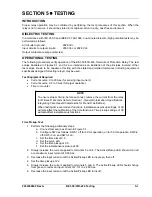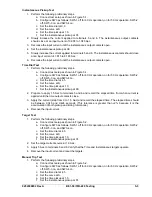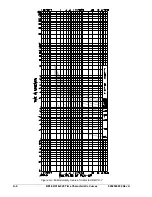
5-4
BE1-50/51B-229 Testing
9252000892 Rev A
2. Set the target current source at 1.0 Aac.
3. Apply 0.9 Aac to terminals 5 and 6. (0.9 Aac provides input power, but remains below pickup.)
4. Connect a jumper between the Time Manual Trip test jacks. Verify that the Time target operates.
Remove the jumper.
5. Connect a jumper between the Instantaneous Manual Trip test jacks. Verify that the
Instantaneous target operates. Remove the jumper.
6. Reset the targets.
Integrating Reset Test
1. Perform the following preliminary steps.
a. Connect test setup as shown in Figure 5-1.
b. Configure SW3 as follows: SW3-1 off for 60 Hz operation, on for 50 Hz operation, SW3-2
off, SW3-3 on, and SW3-4 on.
c. Set the time dial at 9.9.
d. Set the curve at V.
e. Set the time pickup at 1.0.
f.
Set the instantaneous pickup at 90.
2. Set the target current source at 1.0 Aac.
3. Apply 4.0 Aac to terminals 5 and 6. After the relay trips, remove the input current for 29
±
0.25
seconds, then reapply the 4.0 Aac input current. The elapsed time from the reapplication of input
current to the output re-trip should be 2.08 seconds,
±
0.4 seconds.
PERIODIC TESTING
All relays should be tested periodically to identify and correct any problems that are found.
Single-phase relays such as the BE1-50/51B-229 are normally used in groups of four (three phases and
ground) on the protected circuit. This scheme allows one relay to be withdrawn and tested without losing
protection. Only three relays are required at any given time to sense all types of faults on a grounded wye
system. Refer to Figures 5-1 and 5-2 for recommended test setups.
Periodic testing should consist of the following procedures.
1. Verify that the instantaneous pickup is within
±
2% of the value set on the dials. Pickup occurs
when the instantaneous output contacts close.
2. Verify that the time pickup is within
±
2% of the value set on the dials. Pickup occurs when the
LED turns green, then red.
3. Verify that the time to trip for the curve and time dial settings, at a multiple of six, is the same as
the time given on the characteristic curve. Refer to Appendix A,
Time Overcurrent Curves
for the
characteristic curves.
4. Verify that the time to trip for the instantaneous element, at a pickup multiple of two, is not greater
than the time given on the instantaneous characteristic curve. Refer to Appendix A,
Time
Overcurrent Curves
for the characteristic curves.
5. Verify that the targets operate with 1 Aac of trip current in the trip circuits and that they can be
reset using the reset button.
WARNING!
Trip circuit voltage is present at the front panel test jacks. When short-
circuiting the test jacks, use insulated jumpers to avoid contact with this
voltage.
Summary of Contents for BE1-50/51B-229
Page 2: ......
Page 6: ...iv BE1 50 51B 229 Introduction 9252000892 Rev A This page intentionally left blank ...
Page 8: ...vi BE1 50 51B 229 Introduction 9252000892 Rev A This page intentionally left blank ...
Page 10: ...ii BE1 50 51B 229 General Information 9252000892 Rev A This page intentionally left blank ...
Page 20: ...ii BE1 50 51B 229 Controls and Indicators 9252000892 Rev A This page intentionally left blank ...
Page 26: ...ii BE1 50 51B 229 Functional Description 9252000892 Rev A This page intentionally left blank ...
Page 30: ...ii BE1 50 51B 229 Installation 9252000892 Rev A This page intentionally left blank ...
Page 34: ...4 4 BE1 50 51B 229 Installation 9252000892 Rev A This page intentionally left blank ...
Page 36: ...ii BE1 50 51B 229 Testing 9252000892 Rev A This page intentionally left blank ...
















































